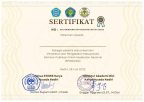VIMASI (Video Animasi dan Demonstrasi) tentang Menstrual Hygiene terhadap Kemampuan Praktik Pada Remaja Putri
Keywords:
adolescent girls, menstrual hygiene practice ability, Animation VideoAbstract
Menstrual hygiene is an action taken to care for and maintain cleanliness in the female area during menstruation, to prevent infection in the reproductive tract. The ability to practice menstrual hygiene can be improved by providing education through the VIMASI method (Video Animation and Demonstration). This study aims to determine the effect of the VIMASI method (Video Animation and Demonstration) on menstrual hygiene on the ability to practice menstrual hygiene in seventh-grade adolescent girls at SMPN 1 Kalidawir. The design of this research is Pre Experimental Design with a one-group pretest-posttest approach without using a control group. The sampling technique using proportional stratified random sampling obtained 39 respondents from 130 populations. The research instrument used a menstrual hygiene observation sheet, with a statistical test, namely the Wilcoxon Signed Rank Test with a significance level of 0.05. The results showed that before being given the VIMASI intervention almost all (76.9%) respondents had the ability in the less category. Meanwhile, after the intervention was given, almost all respondents (92.3%) had good abilities. The mean on the Pre Test is 9.7949 and the Post Test is 28.0256. This shows that there is an increase in the value before and after the intervention is given. Analysis using the Wilcoxon Signed Rank Test obtained a sig (2-tailed) p-value 0,000 ≤ α 0,05. Based on the p-value ≤ α, means that there is an effect of VIMASI (Video Animation and Demonstration) about menstrual hygiene on the ability to practice menstrual hygiene in seventh-grade adolescent girls at SMPN 1 Kalidawir. Preferably, adolescent girls always apply menstrual hygiene practices that have been taught in their daily lives to avoid reproductive diseases.
Downloads
Published
Issue
Section
License
Copyright (c) 2022 Seminar Publikasi Ilmiah Kesehatan Nasional

This work is licensed under a Creative Commons Attribution 4.0 International License.







